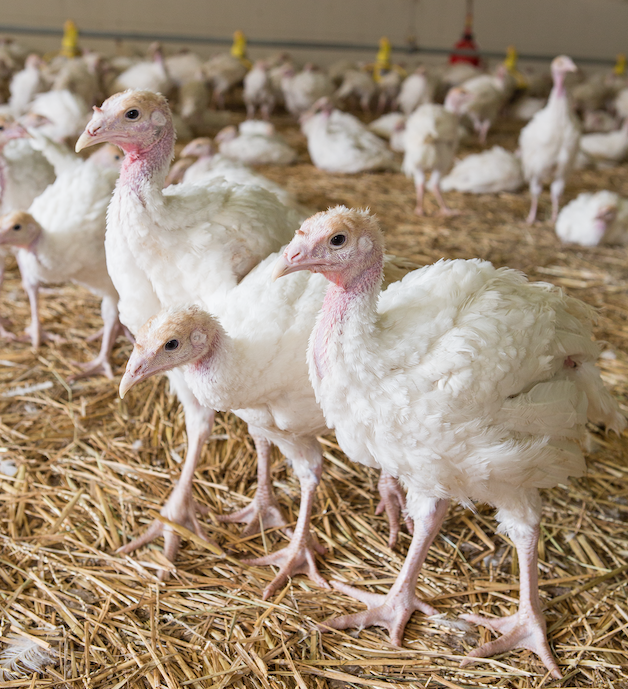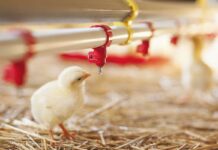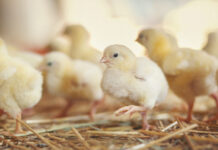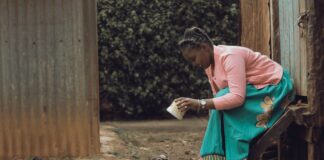
Clostridial Dermatitis of Turkeys (CDT), also referred to as Cellulitis, remains a major disease issue across all geographic regions of the US; the annual industry 2021 survey average score for CDT changed slightly to 3.9 (from 4.0 in prior year) and increased in rank from #3 (2020) to #2.
Steven R. Clark, DVM – Professional Veterinary Services Manager, Turkeys Huvepharma, Inc. Peachtree City, Georgia
CDT is most commonly seen in, but not limited to, commercial male turkeys nearing market age. Clostridium septicum, C. perfringens type A, or C. sordelli are isolated from fluid or affected tissue samples of morbid or dead birds. Affected turkeys present with two or more of the following clinical signs: subcutaneous emphysema (crepitus); serous or serosanguineous subcutaneous fluid; vesicles on the skin, especially on the breast/inguinal area; moist, dark, wrinkled skin, especially breast/inguinal area; cellular necrosis (microscopic); organ involvement (spleen/liver); vesicles on the skin, and/or moist, dark, wrinkled skin, on the tail area. The affected flock will have mortality greater than or equal to 0.5 dead per 1,000- birds, fitting the individual bird definition, for two consecutive 24-hour periods.
Opinions vary as to risk factors and potential causes of CDT. Some of the key areas to control CDT include:
- anaerobic bacteria;
- biosecurity;
- compost management;
- direct fed microbials;
- economics;
- education;
- litter;
- management;
- prescribed medications for treatment;
- 10. removal of mortality;
- 11. Vaccination;
- 12. Zenit (top) 6.
Anaerobic bacteria
- Clostridial organisms are everywhere in the environment, including Clostridium septicum and Clostridium perfringens.
- Culturing clostridia in the laboratory requires a suitable media and specialized anaerobic conditions.
- Clostridia organisms grow readily under anaerobic conditions in the environment.
- Pathogenesis of cellulitis in turkeys is still not completely understood.
-
-
-
-
- One popular “inside-out” theory suggests that the pathogenic clostridia and/or the toxins produced by the clostridial overgrowth enter the bird’s systemic circulation via a damaged intestinal wall, or via oral ingestion and subsequent infection, and deposit in areas under the skin to cause inflammation, gas formation and perhaps additional toxin production.
- A second theory suggests that clostridia enter directly through moist or abraded skin (i.e., “outside-in”).
-
-
-
- Clostridia spores are crucial in terms of the pathogenicity of clostridial diseases because they can survive in a dormant state, as a spore, in the environment and return to normal-growing vegetative bacteria when they are exposed to favorable conditions, such as nutrients or the animal body. Spores are extremely resistant to high temperature, high pressure, toxic chemicals, and even radiation.
- Although the strategies to inactivate (disinfect) clostridia vegetative cells are effective, the inactivation of clostridia spores is still a great challenge.
Biosecurity
-
-
-
- Litter composted from dermatitis flocks and dead bird compost can have clostridium and spores. These spores can be mechanically carried to the poultry barns by farm workers, dogs, rodents and insects. Airborne transmission of clostridia spores has also been reported.
- Dermatitis farms were less likely to require employees to scrub footwear (OR = 0.09).
-
-
Compost management
-
-
-
- Do not compost litter or dead birds within 200 feet of poultry barns.
- A 2009 JAVMA article reviewed the methods and risks of composting animal carcasses. Proper composting eliminates many pathogens and may reduce levels of carcass contamination with spore-forming bacteria, such as, Clostridia. Proper composting requires expertise to manage the process and site. Composting is a largely aerobic degradation process in which microorganisms convert organic material into stable humus. Turning the compost infuses it with a supply of oxygen, thereby supporting thermophilic digestion and a uniform composting process.
- One colleague reported an epidemiological investigation that “proper management” of mortality composters (i.e., contents were turned regularly) significantly reduced the incidence of clostridial dermatitis versus not turning. Also, composters were a risk factor compared to no composter on the farm (i.e., they had a different method of dead bird disposal).
- A 2010 USDA study reported four variables that were significantly associated with clostridial dermatitis status.
- Dermatitis farms were more likely than control farms to compost litter within 200 ft of a poultry barn (odds ratio, OR = 8.3). This means that the odds of a flock contracting dermatitis is 8.3 times greater if “litter compost” is nearby (<200-ft). Consider managing litter disposal and relocating the compost far away.
- Dermatitis farms were less likely to require employees to scrub footwear (OR = 0.09).
- Dermatitis farms were also more likely than control farms to have a soil pH ≥6.0
- And they have humidity level in the barn ≥60 percent.
-
-
Direct fed microbials
- An in vitro testing assay of a Bacillus lichenformis DSM 28710 direct fed microbial’s effectiveness against inhibition of C. septicum isolates from turkeys, is available.
- It is proposed that the active bacillus flora inhibits pathogenic clostridia growth, thereby preventing disease. Limited experiences supplementing direct fed microbials have not completely eliminated the disease.
Economics
- A 2009 industry survey estimated increased production costs due to clostridial dermatitis was 0.014 – 2.5 cents per pound of meat produced.
- A 2022 estimate suggests CDT medication costs increase 80 percent over baseline medication costs
- Supply chain disruptions during 2020 and 2021 have affected the production and distribution of some animal drugs.
Education
- Educate farm personnel on the seriousness of this disease, how to recognize disease, and make sure new outbreaks are diagnosed early and reported immediately.
- USAHA annual surveys
- 2008 Clostridial Dermatitis Panel Proceedings
- 2007 NTF (National Turkey Federation) Workshop
- 2010 USDA NAHMS Report
- Peer reviewed publications and reputable lay journal articles
Litter
- The optimum environment for clostridial growth and toxin production is pH 6-7.
- Litter acidification in the finisher barn at the beginning of bird placement and periodically throughout the duration of the flock may be helpful in reducing numbers of bacteria that cause CDT.
- Also, acidification is recommended following tilling or other litter manipulations.
- Acidify the litter in flocks diagnosed with dermatitis, administer acidifier every 2 weeks with birds in the building and after cleanout.
- Heat stress and the subsequent use of fogging/spraying systems may result in wet litter which may contribute to “blooms” of dermatitis. Consider implementing a litter acidification program in an attempt to decrease clostridia counts.
- Repeated applications of litter acidifiers or disinfectants may be necessary as the resistant spores germinate to the susceptible vegetative stage.
- Manage water spills and any excessive litter wetness as an immediate concern; eliminate wet litter. Wet litter and anaerobic conditions favor growth and multiplication of bacteria that cause CDT. In situations with wet spots, immediate removal of wet litter, or restricting access to wet litter, will reduce exposure to bacteria that cause CDT.
- Cleanout litter after every flock. Completely remove all the litter, followed by washing and disinfecting the barn. Minimize the buildup of clostridial spores.
- In-house composting of litter between flocks has been reported as a method to lower clostridial populations, utilizing thermophilic windrowing and multiple turnings of the pile.
Management
- Specialty equipment that allows managers to easily maneuver heavy tom barns and do chores and pick up mortality, can thus help control dermatitis. These carts might encourage more frequent mortality pick up (management), allow managers to carry appropriate sanitizers to treat mortality spot (sanitation), and they stay in the barns so as not to contaminate other barns (biosecurity).
- Immediately spot-treat the underlying contaminated litter area with litter acidifiers or a disinfectant solution to reduce clostridia and subsequent exposure to other turkeys. The litter beneath birds that have died of CDT is heavily contaminated with bacteria.
- A humane culling policy ensures that morbid birds are immediately removed from the flock.
- Overcrowding is a risk factor. Increased stocking density (kg-bird/sq-m) has been documented to increase the incidence of dermatitis.
- Controlling darkling beetles and flies is critical, as some insects have been confirmed to carry C. perfringens.
-
-
-
-
- Clean up feed spills, and weeds and grass around the barn perimeter, as these attract insects.
- Properly dispose of bird mortality frequently from barns.
- Outside the barn, standing water next to composting litter and mortality, and around barns, attracts and breeds insects. Ensure appropriate fly control around rendering containers too.
- Inside the barn, water spills and wet litter are excellent breeding areas for flies.
- Ensure proper composting techniques.
-
-
-
- Control other potential vectors, such as rodents and wild birds.
- Maintain a dry environment in the barn:
-
-
-
-
- Ventilation: keep relative humidity level in the barn <60 percent.
- Drinkers: properly manage the drinker system height and water depth, as applicable.
- Tilling litter routinely, while birds are in the barn, to minimize wet cake accumulation.
-
-
-
- Avoid feed outages. Flocks that are out of feed for an extended period likely can have a shift in intestinal microflora and integrity which may favor increased clostridia growth. Also, birds can be aggressive when feed is reintroduced, resulting in skin damage and subsequent infection.
- Another management technique occasionally practiced on recurring CDT farms is to replace the scheduled tom flocks with a flock of hens; hens have a lower incidence of CDT and/or the hens are typically marketed at an earlier age before the usual onset of CDT; therefore, hens would be expected to reduce the clostridium load in the poultry house compared to males.
- There are some reported benefits of supplementing the drinking water with iodine. Iodine supplementation has been reported as continuous or for 2-3 days per week in the finisher ages.
- Other identified risk factors include presence of built-up litter in the house, aggressive bird behavior, and stress.
Prescribed medications for treatment
- Start prescribed antibiotic therapy promptly.
- No available antibiotics have an FDA approved label indication for the treatment or prevention of clostridial dermatitis. Therefore, any drug must be prescribed by a licensed veterinarian following extra label drug use (ELDU) guidelines.
- Penicillin G potassium remains the drug of first choice for treating clostridial dermatitis in turkeys, and lincomycin hydrochloride is second choice.
- Federal law restricts these drugs to use by or on the order of a licensed veterinarian: lincomycin hydrochloride, penicillin G potassium, and all tetracyclines.
- Penicillin, lincomycin, tetracyclines and bacitracin have reported in-vitro efficacy against clostridial organisms.
- Effective treatments usually result in decreased mortality within 24-hours.
Removal of mortality
- Pick up all dead birds (mortality) frequently, 2 to 3 times per day.
- Promptly and properly dispose of mortality.
- The principal methods of dead bird (carcass) disposal are rendering, pit burial, incineration, and composting.
- Be certain all morality is removed since the carcasses are sources of clostridium contamination to other birds and the environment.
Vaccination
- Vaccinate at-risk flocks with autogenous bacterins and toxoids.
- Some universities have been researching clostridial dermatitis for years to better understand pathogenesis and control, including oil emulsion vaccine on immune response, morbidity, and mortality under laboratory and commercial conditions.
- Recent field evaluations with an innovative new USDA approved vaccine labeled to control necrotic enteritis (NE) in broilers due to Clostridium perfringens Type A have shown some promise. The vaccine utilizes proprietary and unique recombinant attenuated Salmonella vaccine (RASV) technology expressing Clostridium perfringens genes coding for an α-toxin fragment & NetB toxin. The vaccine is prescribed by a veterinarian and trialed on turkey farms with a history of Clostridial Dermatitis.
Zenith (top) 6
- Early recognition.
- Removal of mortality 2-3 times per day.
- Medicating affected flocks with prescribed antibiotics (follow all withdrawal times).
- Promptly managing all water spills and wet litter.
- Avoid feed outages.
- Compost management.
References are available on request
From the Proceedings of the Midwest Poultry Federation Convention 2022

















